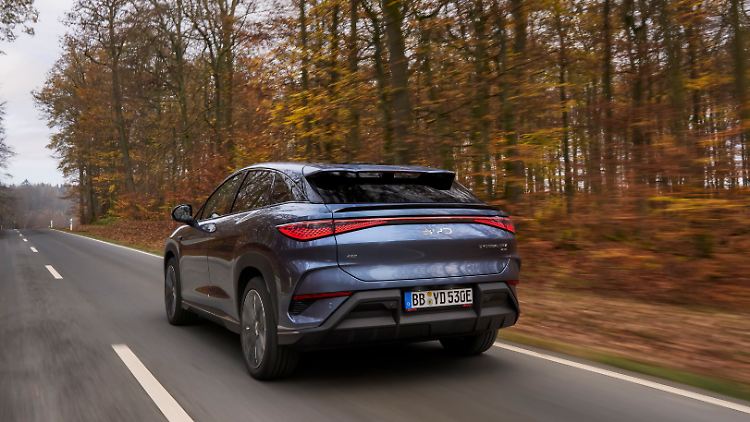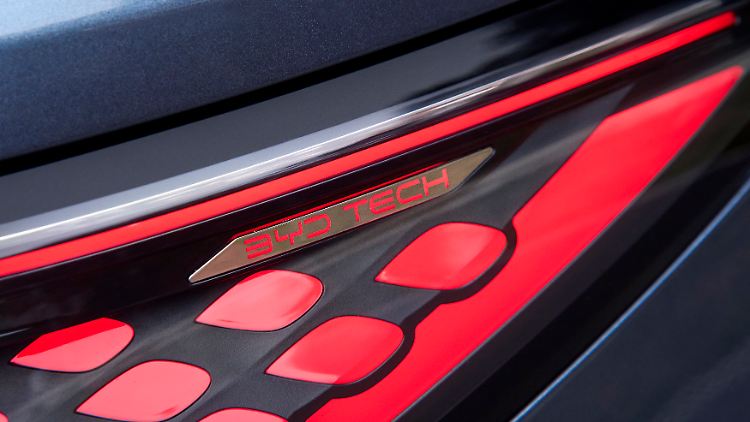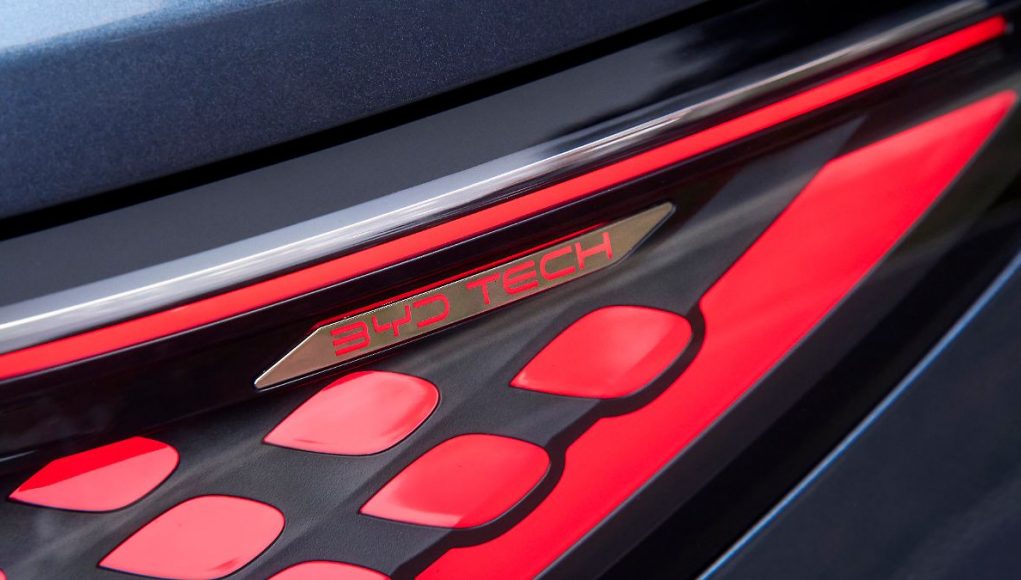With a new sporty crossover concept, BYD wants to score even more points than before with emotional car construction. And by the way, the Chinese manufacturer could lure away Tesla Model Y customers. ntv.de moved the Stromer.
One thing in the context of the new BYD Sealion 7 makes you sit up and take notice. The technicians wrote the engine speed remarkably often under the engine exhibits in the exhibition of individual vehicle components: it is 23,000 revolutions per minute. The fact that this fact is not entirely trivial can also be seen from the following technical specification – according to the factory, the Sealion travels at 215 km/h. That's pretty fast for an electrically powered vehicle, especially for a Chinese make. The matter seems clear: Chinese manufacturers want their products to also be found attractive in Germany, the market that many experts consider to be the most demanding in the world.


The new BYD SUV looks European-pleasing.
(Photo: BYD)
This much has been spoiled: Those responsible still have to work hard until BYD (Build Your Dreams) reaches a level of quality that can convince demanding local customers. But more on that later. After getting into the Sealion, you find yourself on finely padded and comfortable nappa leather armchairs. Could these be suitable for your next vacation? But yes! The weak point inside is the somewhat confusing menu on the huge touchscreen. You simply need longer to familiarize yourself with the complex matter of operation and function. This also includes switching off unpleasant assistants, of which the Sealion has plenty. It doesn't help much that the monitor can be rotated.
The all-wheel drive Sealion is a bundle of dynamics
The gear selector lever in the center console has a classic design so that “D” slides in intuitively. And then it gets exciting. How do two electric power packs with a cumulative output of 530 hp (218 hp at the front and 313 hp on the rear axle) move the 2.4-ton truck? We recommend taking a look at the model lettering. The “4.5S” on the trunk lid is not a displacement designation, as you might imagine. It says that the Sealion accelerates to 100 km/h within 4.5 seconds. Interesting approach.


Given the almost 1,800 liter luggage compartment volume, you can safely consider the BYD Sealion 7 to be a small pack mule.
(Photo: BYD)
But of course, the all-wheel drive vehicle is already making a powerful start, and this promise is practically reflected in the numbers. However, the maximum torque of 690 Newton meters is not available all at once; the electronics model a moderate increase even under full load. Feels comfortable.
But does that make the Sealion 7 an athlete? Not really. It makes a rather comfortable impression. And people who are into active driving may find the travel crossover a tad too synthetic with the smooth, undefined steering. And as nice as the top speed is beyond 200 km/h, the BYD feels really comfortable up to speeds of around 160 or 170 km/h – which, by the way, is completely sufficient.
When it comes to battery technology, BYD is fit
And since we're talking about BYD, the battery company, the question remains what kind of power storage is actually under the sheet metal. Of course, the modern “Blade” battery. Of course, that's a marketing term, but you can hardly deny the company's competence in battery technology with the second most or at times even the most electric vehicles sold globally.


Striking LED technology at the rear also gives the new BYD recognition value.
(Photo: BYD)
The Sealion 7 uses an LFP memory, which has many arguments in favor of it. Avoiding fundamentally environmentally harmful raw materials such as cobalt and nickel would be one thing. Low costs would be another. And BYD also knows how to pack the cells in a compact way, which saves space.
The Chinese also work with so-called cell-to-body technology, in which the cells are a structural part of the substructure. This principle is not without controversy, as repairs in the event of a crash are considered expensive.
BYD only brought the version with the large battery to the driving presentation – meaning 91 kWh. And that in turn means a lot of range. During the test drive, the on-board computer showed 334 kilometers with a charge level of 66 percent. Which in turn means a real range of over 500 kilometers. And ntv.de didn't put too much strain on the two engines of the 4.83 meter long tourer during the test drive.
Whether the Sealion 7 still charges quickly remains to be seen in a later test. In any case, the data sheet states a maximum charging power of 230 kW, which doesn't sound bad. Accordingly, the battery should be able to go from 10 to 80 percent charge within 24 minutes. And not only can it be discharged using a drive, but the user can also connect external devices with an output of up to 3.3 kW to the vehicle (vehicle-to-load technology).


You can hardly complain about the material processing. The somewhat Asian-kitsch design takes some getting used to for Europeans.
(Photo: BYD)
Towards the end of the test drive, a few final impressions emerged that could be valuable as suggestions for BYD management. While the exterior design of the Sealion 7 looks quite European, the interior design is a bit too kitschy for local standards. The team still needs to create a slightly more harmonious smell inside. It works with other models too.
On the other hand, the easily accessible charging cradle with 50 watts of charging power is positive – but why display the ventilation nozzles in such an aesthetically insensitive way? And in the future, please give the automatic air conditioning a little more fine-tuning, as its heating output fluctuates quite a bit.
Nevertheless, the bottom line is that this BYD is a solid offer with the ability to convince Europeans in general and Germans in particular. It is also a practical model with a maximum luggage compartment volume of almost 1,800 liters.
Now the price would be exciting – but BYD has yet to announce it. Perhaps in this context it would be good to know that the Sealion 7 comes with 313 hp and rear-wheel drive. Top speed remains at 215 km/h. In this case, the battery only offers 82.5 kWh capacity and then charges with a maximum of 150 kW. Still more than enough. The Sealion 7 will be starting in a few weeks. Let's see whether it earns a place in the local streetscape.
































